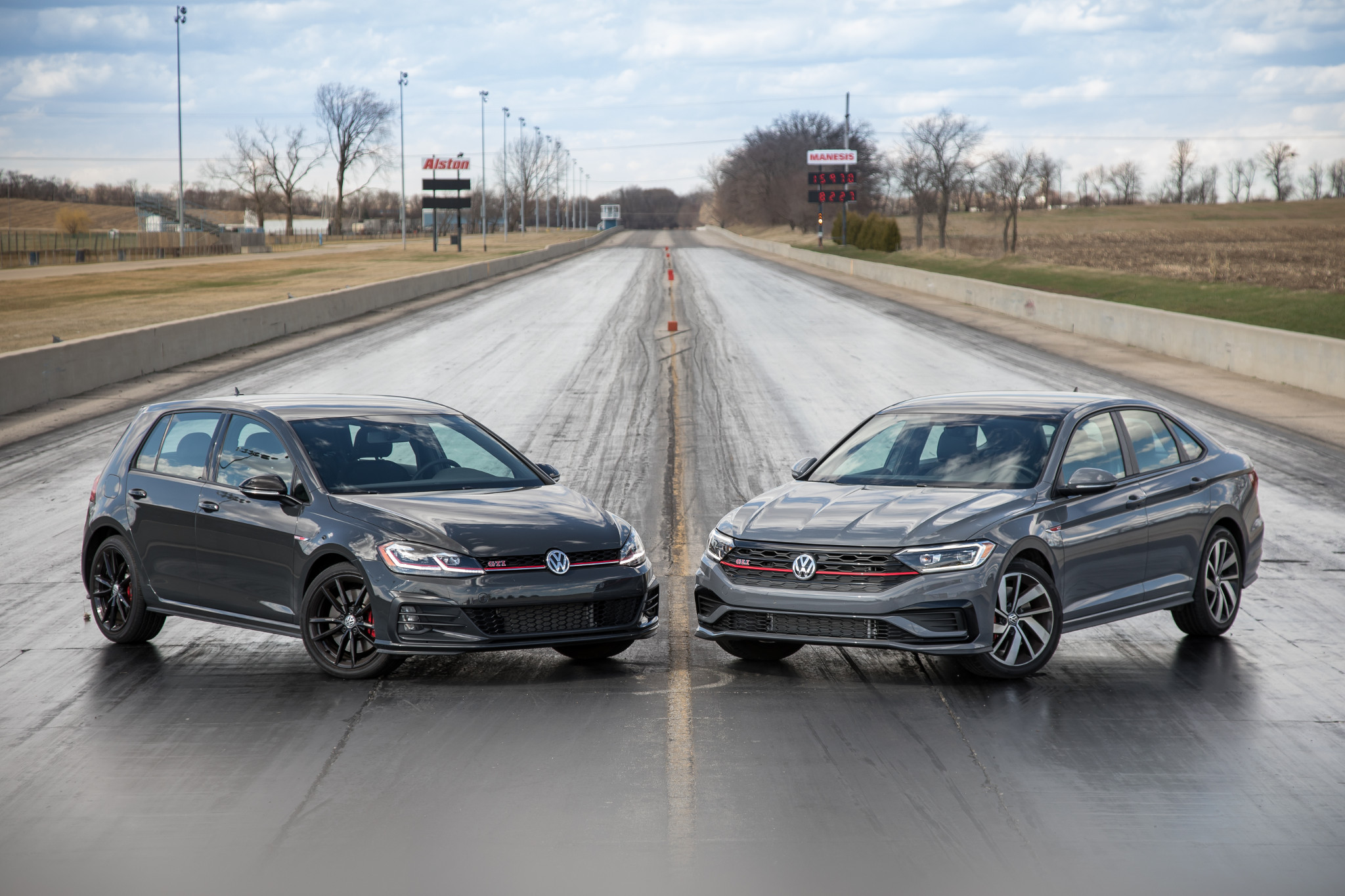Volkswagen calls the Jetta GLI the sedan-i-fied Golf GTI, which is not a statement to be taken lightly. The GTI is a beloved sports compact that beat all others in our $30,000 Cheap Speed Challenge and has continually been at the top of its game (except for that one time). When the GLI was retooled for 2019 to match the GTI’s componentry even closer than before, we had to ask: Can you now get the Jetta’s bigger backseat and large trunk with the GTI’s snappy dynamics? Is the GLI finally that good?
Related: Compare Golf GTI and Jetta GLI Specs
Cars.com reviewer Mike Hanley and I tested the GLI’s and GTI’s acceleration, braking, handling and everyday livability on a mix of closed courses (many cones were sacrificed) and streets to see if the new GLI has GTI levels of goodness. The results may be surprising based only on the numbers: The Jetta GLI out-accelerated and out-braked the GTI. And for just $295 more, it included a significant number of convenience and comfort features the GTI didn’t. Did the GLI just pull off a win?
The Pesky Difference Between What We Tested
Both cars shared power and torque specs, the optional seven-speed dual-clutch automatic transmission, the trick VAQ limited-slip front differential and the standard, fixed-firmness suspension (not the optional, adjustable-firmness shock absorbers). Where they diverged and created a theme that was a thorn in our sides throughout the test was that the GLI had optional, no-cost summer tires with loads of sticky grip, while the GTI wore all-season tires with the at-the-limit road-holding ability of skateboard wheels.
2019 Volkswagen Jetta GLI Autobahn
- Price: $31,185
- Engine: 228-horsepower, turbocharged 2.0-liter four-cylinder engine with 258 pounds-feet of torque (on premium gasoline)
- Transmission: seven-speed dual-clutch automatic
- Tires: summer, Hankook Ventus S1 evo3, P225/45/18
- Gas mileage: 25/32/28 mpg city/highway/combined on regular gasoline
- Zero-to-60 mph: 5.84 seconds
- Quarter-mile acceleration: 14.05 seconds at 99.17 mph
- 60-to-zero-mph braking: 111.55 feet
- As-tested weight: 3,295 pounds
2019 Volkswagen Golf GTI Rabbit Edition
- Price: $30,890
- Engine: 228-hp, turbocharged 2.0-liter four-cylinder engine with 258 pounds-feet of torque (on premium gasoline)
- Transmission: seven-speed dual-clutch automatic
- Tires: all-season, Bridgestone Potenza RE97 A/S, P225/40/18
- Gas mileage: 25/31/27 mpg on regular gasoline
- Zero-to-60 mph: 5.96 seconds
- Quarter-mile acceleration: 14.12 seconds at 99.64 mph
- 60-to-zero-mph braking: 127.66 feet
- As-tested weight: 3,145 pounds
Acceleration: GLI Faster, Not Better
The outgoing 2018 GLI’s engine output was neutered compared with the GTI, making considerably less torque and less horsepower. The 2019 GLI brings equal power, torque and similar weight to the GTI, plus the same transmission gear ratios, so you give up zilch in acceleration times compared with the GTI. The GLI was actually a little quicker, hitting 60 mph in 5.84 seconds versus the GTI’s 5.96 seconds. The advantage came from the GLI’s summer tires that combined with the limited-slip front diff and launch control to plant power to the ground with no drama. The GTI’s wheelspin and hammering wheel hop meant a more delicate start for its quickest times.
The larger difference between the GLI and GTI surfaced outside of measured testing, perhaps where it matters most. The GTI’s snappier accelerator responsiveness and an eagerness at throttle tip-in made it the livelier of the two. Every fine movement of the accelerator pedal shot the GTI’s engine to life, and while both have the crisp-shifting dual-clutch gearbox, our GTI test car was more eager to downshift in the various driving modes. To our ears, the GLI’s engine sound relies significantly on augmentation through the audio system (adjustable) to create an in-cabin aural experience, almost comically when you engage Sport mode and it amplifies the effect like a spaceship just landed in the backseat. While the GTI also employs this engine sound adjustability, it’s combined with more natural turbo whistling and exhaust barking on upshifts that are inaudible on the more reserved GLI.
Brake Testing: You Will Notice a Difference
Both cars use the hot-shot Volkswagen Golf R’s front brakes with 13.4-inch-diameter, 1.2-inch-wide vented rotors, though the rear brakes on the GLI are slightly smaller at 11.8 by 0.5 inches and are solid versus 12.2 by 0.9 inches and vented for the GTI – vented rotors have cooling properties that make them less susceptible to overheating and brake fade during heavy use, like track days. In our 60-to-zero-mph emergency braking tests, however, the difference between the two came from the summer tires on the GLI, which provided more grip and commanding stopping distances. The all-season tires on the GTI forced the antilock brakes to chatter the car to a stop. GLI: 111.55 feet. GTI: 127.66 feet.
Handling and Ride Quality
The GLI’s grip with summer tires routed it briskly through our tight handling course with little drama. The shorter-wheelbase GTI with its all-season tires turned in quicker and flicked between corners with eagerness where the GLI bombed through the course with grip but wasn’t much fun doing so, with slower transitions between corners (it’s marginally heavier and has a 2-inch-longer wheelbase). With the electronic stability system in Sport mode and the electronic safety net eased, the GTI eagerly snapped the rear end around, pointing the nose toward the next cone, though with the overall pace slowed to keep from overpowering the Golf’s traction-limited tires.
From the driver’s seat, we still favored the GTI because it delivered more feedback through the steering wheel and seat, letting you know that the front or rear was at its grip limits, giving little twinges through the chassis when we clipped the base of a cone or ran through loose gravel. Plus, the GTI Rabbit Edition’s plaid cloth seats have side bolstering that hugs and keeps you in place versus the slippery, flatter leather seats in the GLI.
The tires made less of a difference on public roads where we weren’t pushing the cars to their grip limits. Instead, we observed the fine differences in the GTI’s sharp, playful handling and eagerness to bounce between corners than we did on the cone course, but in this case without turning the GTI’s front rubber into dust constantly combating the loss of front grip and wheel slippage.
At highway speed, the GLI’s longer wheelbase helped it drive more relaxed, delivering less jouncing than the GTI, which feels taut and readier to pounce than the lounge-ier GLI’s ride. However, the GLI’s summer tires had slightly more impact noise over bumps and expansion joints than the GTI’s all-seasons.
Backseat Comparison
The Jetta’s backseat is the roomier choice. Oddly, the Jetta doesn’t have air vents in the back of the center console like the GTI does, potentially limiting comfort for backseat passengers, which is a strange omission for the car with the backseat that you want to sit in. The GLI is also more accepting of a bulky child seat. My tank of a Britax Advocate ClickTight rear-facing child seat left little usable room for a front passenger in the GTI, while at 6 feet tall I could easily fit in the GLI’s front passenger seat with child seat installed. In our official child seat fitment testing, the Golf scores well but is knocked down a notch in rear-facing infant seat installation for how far the front passenger seat needed to be moved forward.
Sedan Versus Hatchback Cargo Space
You can’t compare the Jetta GLI’s 14.1 cubic feet of trunk space to the Golf GTI’s 17.4 cubic feet of hatch space and conclude the GTI is the more cargo friendly based on numbers alone. Cars with open spaces like a hatchback are measured differently than ones with closed spaces like a trunk. In practice it’s a matter of how you plan to use the car. The GTI offers more SUV-like usability for taller cargo items. But if you can’t fold the backseat, like if there are honkin’ child seats installed, and you’re not hauling tall stuff, the Jetta may give you an edge with its shorter, but deeper trunk. A bonus for the GTI is that in addition to its 60/40 split, there’s a pass-through for narrow objects the Jetta doesn’t have.
More From Cars.com:
- 2019 Volkswagen Jetta GLI Might Be the Jetta to Buy if You Insist on a Jetta
- 2019 Volkswagen Jetta GLI: Budget Sports Sedan
- 2019 Volkswagen Jetta GLI: A Subtle Sports Sedan Experience
- 2019 Volkswagen Jetta GLI for Sale Near You
- 2019 Volkswagen Golf GTI for Sale Near You
For $31K, Which Should You Buy?
It’s wild that the Jetta GLI we tested was only $295 more than the as-tested GTI. The Jetta’s digital instrument panel, panoramic moonroof, ventilated leather front seats, remote start, larger touchscreen, premium stereo, dual automatic climate control and power driver’s seat with memory function are big features to include for less than the cost of an Apple Watch. There’s significant value in the 2019 Jetta GLI as far as features for the money, but is the GLI now really a GTI with a trunk and bigger backseat? Ehhh, no. The 2019 Jetta GLI is closer than ever, but the GTI is still the ultimate pick for those looking for maximum driving enjoyment. Perhaps the biggest takeaway is that those who previously didn’t consider a GTI because it was too small now have a much worthier option in the 2019 GLI.
Cars.com’s Editorial department is your source for automotive news and reviews. In line with Cars.com’s long-standing ethics policy, editors and reviewers don’t accept gifts or free trips from automakers. The Editorial department is independent of Cars.com’s advertising, sales and sponsored content departments.
Source: Read Full Article









